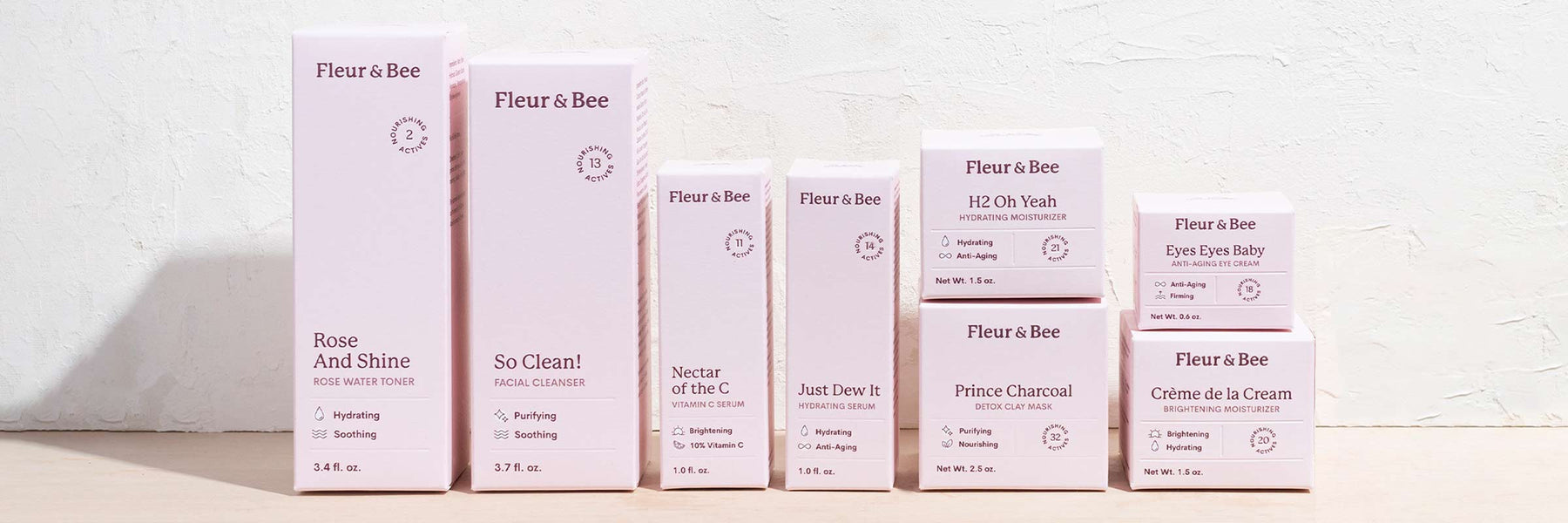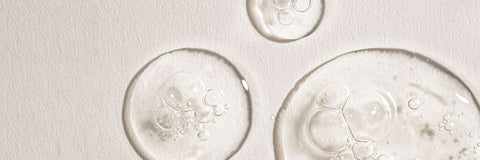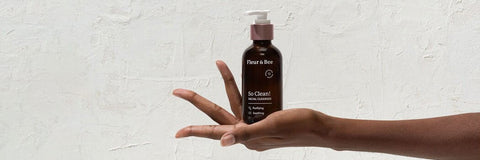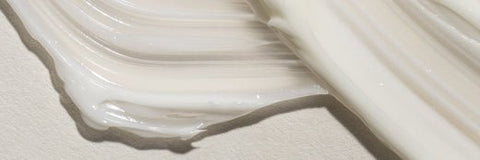If you’re familiar with Fleur & Bee, you probably know that being a socially responsible company is of paramount importance to us. Part of that commitment is delivering great products that are both vegan and cruelty-free. You won’t find any animal ingredients or animal byproducts in our skin care line, and we're a Leaping Bunny™ certified, cruelty-free brand.
For that reason, we wanted to discuss what cruelty-free skin care is and why it matters, go over a quick history of animal testing and what that testing has done to animals, talk a little bit about groups like Leaping Bunny, and finally, discuss how to tell if skincare really is cruelty-free.
IN A NUTSHELL
Main Takeaways: Cruelty-free means that a product (and ingredients within that product) were never tested on animals. It also means that a company does not allow the product to be tested on animals after it is formulated.
Good to Know: Technically, the government does not regulate the use of the term “cruelty-free”, so third party organizations, like Leaping Bunny, have stepped in to provide cruelty-free certification.
Recommended Products: All Fleur & Bee products are Leaping Bunny™ certified as cruelty-free.
What Does Cruelty-Free Skin Care Mean?
Cruelty-free skin care is one of those terms that’s tossed around a lot but isn’t really all that well-defined. Many assume that if a product is labeled “cruelty-free,” that means that no animal testing has occurred to produce it. But the truth is, the term “cruelty free” is not regulated in the U.S. or Canada. Thus, the definition of what makes a product cruelty-free can vary depending on who’s using the term.
Cosmetics companies generally use the term “cruelty-free” to mean that no animal testing has occurred on the finished product, but that does not mean that testing did not occur on ingredients. Nor does it mean the company didn’t hire an outside company to do animal testing while still calling it “cruelty-free.” It also doesn’t necessarily mean that the company didn’t do animal testing to comply with distribution regulations in other countries.
So how do you know if a skin care product really is cruelty-free in every possible aspect? Well, one way is to look for the Leaping Bunny Program logo. Certification in the Leaping Bunny Program means that a company is completely and truly cruelty-free in the way most people assume—no animal testing at any point by anybody, for any reason.
What is Leaping Bunny?
According to fda.gov, cosmetics companies may throw around terms like cruelty-free or “not tested on animals” because “there are no legal definitions for these terms.” (What?)
As you can imagine, because of this oversight, beauty companies began setting their own standards for using these terms, employing logos and verbiage that gave consumers the impression their products were entirely cruelty-free, when in fact, they may not be.
In order to put some concrete parameters on these terms, LeapingBunny.org states that “eight national animal protection groups banded together to form the Coalition for Consumer Information on Cosmetics (CCIC). The CCIC promotes a single comprehensive standard and an internationally recognized Leaping Bunny Logo. We work with companies to help make shopping for animal-friendly products easier and more trustworthy.”
The resulting list of standards is a tough, restrictive, comprehensive set of cruelty-free criteria to which products and companies must adhere entirely. Officially called “The Corporate Standard of Compassion for Animals,” or, as it is known colloquially, “The Standard,” it is a rigorous test to show that there are no holes in the process at any point.
Companies that pass this test can prove they not only do not resort to any kind of animal testing or cruelty, they don’t incorporate ingredients from companies that do. They can prove their supply chains are free of animal cruelty and testing, and they agree not to resort to animal testing to comply with the requirements of other countries. In short, any company that wants to be able to use the Leaping Bunny logo has to pass a very comprehensive test.
And we’re proud to say that we are a Leaping Bunny Certified skincare company.
If you want to read all the requirements, you can do so here. As you’ll see, every company, no matter how big or small, needs to not only comply with all the standards we mentioned above and then some, but they have to also pass an independent audit. The Leaping Bunny Certification is pretty much the gold standard in our industry.
In addition, companies that make the list have to recommit every year in order to stay on it. One of the main points of our our mission is to provide effective, clean and cruelty free skincare products, and we are happy to say that will never change.

History of Animal Testing
Like all historic events based in cruelty, the history of animal testing is not an easy one to digest, especially for animal lovers. That said– like all history– those who forget the mistakes of the past are doomed to repeat them; so with that in mind, we’d like to go over a few key points in the history of animal testing.
While today we see animal testing for cosmetics as cruel and unnecessary, it started out as a way to protect humans from unsafe cosmetic products. In 1938, the United States Food, Drug & Cosmetic Act became law, and required cosmetics companies to prove their products were safe. In an effort to do so, cosmetics companies responded by testing products on animals.
The first of these tests was constructed in the 1940s. Known as the Draize test, it involved administering the substance in question into the eyes of a conscious animal, usually a rabbit. The substance generally stayed in the rabbit’s eye for 14 days, after which, the animal’s eyes were evaluated for irritation or other ill effects as a predictor of how the substance would affect humans. Often, those animals adversely affected by the test were euthanized.
Not until the 1980s were cosmetics companies pressured into stopping this practice, In 1996, animal protection groups formed The Coalition for Consumer Information on Cosmetics. “The coalition manages the Leaping Bunny cruelty-free certification program in the United States and Canada,” according to HumaneSociety.org.
Two years later, the U.K. banned animal testing.
In the year 2000, the Interagency Coordination Committee on the Validation of Alternative Methods (ICCVAM) Authorization Act was enacted, establishing alternative testing methods in the U.S.
Throughout the 2000s and 2010s, other countries, states, and cities followed, either banning the use of animals in cosmetics testing or banning the sale of animal-tested cosmetics. Among the places to enact these bans are Israel, New Jersey, New York, most of the EU, Guatemala, Rio de Janeiro, and Russia.
That said, animal testing still frequently occurs to this day. According to Humane Society International, “In four out of every five countries, it’s still legal to use rabbits and other animals in cruel toxicity tests of cosmetic products and their ingredients.” They also make the point that there are countries that legally require animal testing for some cosmetics.
In a nutshell, while great strides have been made in the push towards cruelty-free skin care, there’s certainly still a long, long way to go before animal testing for cosmetics is completely abolished.
What Testing Has Done to Animals
The list of what testing has done to animals is, unfortunately, long, varied, and, to anyone who cares about animals, simply barbaric.
The Draize test alone has been known to cause everything from blindness to bleeding in rabbits who are often completely restrained during these tests and struggle to be let loose.
Other tests, including those for Botox, cause immense suffering, according to CrueltyFreeInternational.org: “In these horrific tests, mice are injected with poison before slowly suffocating to death through muscle paralysis while fully conscious.”
And of course, that’s not even taking into consideration the psychological toll these tests take on animals. According to the Humane Society International, tests for products like mascara, hair care products, and other cosmetics have a devastating effect: “Terrified mice, rabbits, rats and guinea pigs have substances forced down their throats, dripped into their eyes or smeared onto their skin before they are killed.
One of the most upsetting parts about these tests is that they are totally unnecessary, according to most experts and animal rights organizations. Most of the ingredients being tested are not new and thus, there is no real reason to test them, even if they are being used in new products.

Animal Rights Groups
Thankfully, there are many wonderful groups that are working diligently to protect animals from cosmetic testing.
As we mentioned above, Leaping Bunny, which is a coalition of eight national animal protection groups, is one of the most prominent animal rights organizations in the country. Those groups include:
American Anti-Vivisection Society
Humane Society of the United States
National Anti-Vivisection Society
Another animal rights organization you may have heard of is PETA, or People for the Ethical Treatment of Animals. Started in 1980, it is “dedicated to establishing and defending the rights of all animals.” Concentrating “on the four areas in which the largest numbers of animals suffer the most intensely for the longest periods of time: in laboratories, on factory farms, in the clothing trade, and in the entertainment industry,” it has brought landmark legal cases against companies in all of those areas to ensure the safety and welfare of animals being abused in those areas.
Other organizations look after the wellbeing of specific animals or groups of animals. Examples include the Jane Goodall Foundation, which protects chimpanzees, and the Tusk Trust, an organization that fights against animal poaching in Africa.
The bottom line is, if you’re interested in looking after the rights of animals in any capacity, there’s an organization out there to partner with or support.
How to Tell if Skincare is Cruelty Free
Leaping Bunny has put together a database of companies that have complied with “The Standard” and have earned the official Leaping Bunny logo. You can access the database here. Not only can you look up skincare products, you can also search everything from dental products to carpet cleaner.
The Fleur & Bee Commitment to Being a Cruelty-Free Company
Whether it’s our So Clean! natural cleanser or our Nectar of the C serum, if you’ve ever watched the video demonstrations of our products, you’ve heard us say that they’re made “the right way, with safe, natural ingredients.” Part of what we mean by “the right way” is that they’re entirely cruelty-free.
In keeping with the standards and ethics that allowed us to earn the right to use the official Leaping Bunny logo, we make sure that not only do we not subject any animals to cruelty to create our products, we carefully monitor our supply chain to make sure that no product—from our serum to our moisturizer—has been created at the expense of any animal.
Our products are also 100% vegan, so we don’t use any animal ingredients or animal byproducts in anything we sell.
So the next time you’re applying our best selling eye cream, you can rest assured no animal suffered to make it. That’s our promise—both to you, to ourselves, and all living creatures, great and small.







